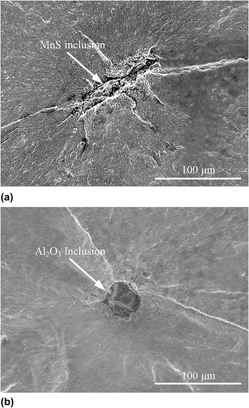Article contents
A method to rapidly and accurately evaluate the maximum inclusion size in medium strength steel
Published online by Cambridge University Press: 19 August 2016
Abstract

The object of this paper is to propose a novel method to evaluate the maximum inclusion size in medium strength steel by ultrasonic fatigue testing. The inclusion sizes in the medium strength steel were evaluated by ultrasonic fatigue testing using the fatigue specimen with a large risk volume under water-cooling condition. To ensure fatigue specimens of medium strength steel fracture from the internal inclusion, heat treatment and oxynitrocarburization were conducted to increase the strength of the specimen and to protect the specimen from surface corrosion induced by cooling water. The results show that evaluation of the inclusion size by the proposed method is more accurate than traditional approaches, which are based on inclusion size characterization from arbitrary two dimensional cross sections. Additionally, as the method is based on fatigue testing in the ultrasonic frequency regime, it can be conducted in a reasonable amount of time.
- Type
- Articles
- Information
- Journal of Materials Research , Volume 31 , Issue 18: Focus Section: Reinventing Boron Chemistry for the 21st Century , 28 September 2016 , pp. 2817 - 2824
- Copyright
- Copyright © Materials Research Society 2016
References
REFERENCES
- 3
- Cited by



